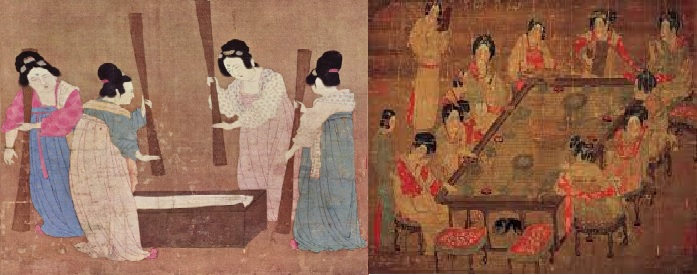Written by: Farheen Ahmed
Posted on: September 16, 2021 |  | 中文
| 中文
Court ladies preparing newly woven silk, created by Emperor Huizong of Song Dynasty
Silk was discovered many millennia ago in China. However, Chinese legend has it that silk was not used as a fabric until the 27th century BC, when Empress Xi Ling Shi found a silk worm’s cocoon floating in her tea cup and was fascinated with its shiny unravelling threads. The fabric became very popular among the elite in China and during the Han Dynasty’s rule was also commonly used as a medium for painting, helping shape China’s rich visual history.
Many emperors and empresses had artists create special silk paintings to be hung in their courts. Silk paintings were also used to honor the deceased. The earliest evidence of such paintings belongs to the Warring States Period (476 BC) in Chinese history. These paintings were found in a tomb in Changsha, and they represent a man riding a dragon and a woman with a dragon and a phoenix. It is believed that funerary paintings bring peace to the souls of the deceased.

(Left) A close up of Emperor Huizong's silk painting, Court Ladies Preparing Newly Woven Silk and (Right) A Palace Concert, a Tang Dynasty silk painting
Silk painting combines two distinct Chinese art forms, sinuous brushwork and the careful spinning of silk fabric. Both these things require precision, and should be handled meticulously. In the past, stones were used to smooth out the silk and create a level surface before applying paint. Artists preferred to do this on their own so that they could prepare a flawless canvas on the fabric. Paint brushes made of animal hair were then used to create different designs and calligraphy. As tools and techniques developed, artists were able to add more colors and nuance to their paintings. Over time, portraits, depictions of mythological creatures and folklore paintings became particularly popular.
Generally, Chinese silk paintings are classified into three categories, according to the themes they reflect: figures (people and scenes from everyday life), landscapes (scenic backdrops) and birds and flowers (flora and fauna). Landscapes are considered the highest form of painting due to the level of detail involved. There are two techniques with which silk paintings are made, the Gongbi and the Shuimo techniques.
Gongbi roughly translates to meticulous brushwork, and this technique requires a lot of precision and skill. Different brush sizes are used, and varying levels of pressure is applied to the brushes in order to create light and dark strokes on silk. Gongbi paintings are made with multiple layers of vibrant pigments and with fine brushstrokes, in order to achieve a likeness to real-life objects. The objective behind this technique is to give pleasure to the viewer, and add details that may not be picked up immediately.
The other technique, Shuimo, is freer in style. As compared to Gongbi, there is little emphasis on detail. Both black and colored ink may be used, but the aim is to capture the essence of the subject rather than to achieve an exact likeness. Adding too many layers and exaggerations is avoided.
As a tradition that has not only survived numerous dynasties but has also played a role in documenting history, silk paintings are an important part of China’s legacy. These paintings perhaps require more time and dedication than other art forms. Though contemporary artists have a wider range of tools at their disposal, they still follow many of the same procedures that were used decades ago in order to maintain tradition. The use of such fine and delicate fabric necessitates careful handling. In today’s fast-paced world, silk paintings remind us of the wonders that can be achieved with time and consistent hard work.
You may also like: